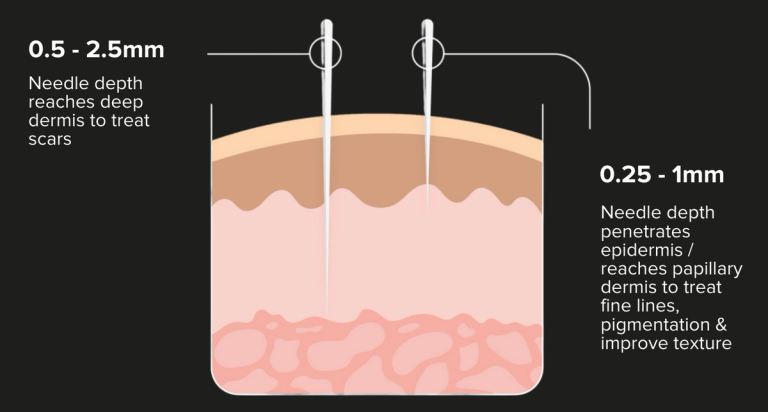Microneedling - At a glance
What is microneedling?
Microneedling, also called medical needling, collagen induction therapy (CIT) or percutaneous collagen induction (PCI), is a skin treatment used to treat:
- wrinkles
- fine lines
- scars (including acne scarring)
- stretch marks
- large pores
- hair loss
- pigmentation
Microneedling uses multiple fine, sterile needles to puncture the skin with microscopic channels.
This intentional, controlled injury initiates a skin healing response, resulting in the increased production of collagen and elastin. The end result is thicker, plumper, firmer, smoother skin. Additionally, skincare products are able to penetrate more deeply into the skin, making them more effective.
Microneedling can be done in one of two ways:
One option is using a dermaroller. A cylinder with many fine, sharp needles is rolled over the target area. The needles are of various lengths, depending on the qualification level of the practitioner, the area to be treated and type of skin issue.
Alternatively, your practitioner may use a microneedling pen. These are handheld pen-like devices (e.g. Dermapen®) which have around 12 fine needles on the tip. Once switched on, these needles move rapidly in and out of the skin, at a depth set by the practitioner.
You can use dermarollers at home, however, medically qualified practitioners can use dermarollers and/or microneedling pens, which penetrate deeper into the skin, giving much better results. Additionally, you are at increased risk of infection due to poor sterilisation and storage, and increased risk of track marks due to needles being blunt.
Common brands include:
- MTS-Roller®
- Roll-CIT®
- SkinPen®
- Dermapen®
- eDermastamp®
Microneedling can also be combined with other treatments such as PRP (platelet-rich plasma) therapy and mesotherapy.
The microneedling Glowday Treatment Guide has been guest edited and medically verified by Roisin Hopkins.
How does microneedling work?
Collagen is the scaffolding of the skin. As we age collagen production declines, particularly after the age of 30. Many anti-ageing and skin rejuvenating treatments are predicated on increasing the skin's own production of collagen. Microneedling is no different.
The microneedling device causes controlled, intentional injury to the epidermis as it is rolled across or applied to the skin. The depth the needles penetrate (0.25mm - 2.0mm) depends on the type of skin issue, the qualification level of the practitioner and the area of the body/face being treated. Nurses, doctors and dentists can deliver microneedling up to 1.5mm on the face and 2.0mm on the body. Aestheticians can deliver microneedling up to 1.0mm on the face and 1.5mm on the body.

The channels produced as the microneedling device is applied to the skin induce a natural skin repair response. This results in increased production of growth factors, which in turn stimulates the production of collagen and elastin. As more collagen and elastin are produced, the skin becomes smoother and plumper.
There is an additional benefit, if using an active skincare regimen, as the products applied to the skin penetrate more deeply following microneedling treatments.
To get the best results, a course of 3-9 treatments may be recommended, followed by a quarterly maintenance programme.
Whilst dermarollers are available at home, it is important to recognise that professional medical microneedling is carried out by experienced professionals, using sterile, sharp dermarollers/microneedling pens with specific aftercare procedures.

Who is microneedling good for?
Microneedling is suitable for all adults and is used for the following:
- To improve acne scarring
- To improve fine lines and wrinkles
- To improve skin texture - tightening and plumping
- To reduce pore size
- To reduce stretch marks
- To improve skin pigmentation
- To help treat alopecia
How do you prepare for microneedling?
Your practitioner should clearly indicate what the specific treatment can and cannot deliver in terms of results.
You may be asked to adopt a particular skincare regimen for 4+ weeks prior to your first treatment, the period between that and any other subsequent treatments, and once your course of treatments has been completed. This is to maximise collagen production and skin repair.
Arrive at your appointment without any makeup.
A week before the treatment, avoid taking aspirin, ibuprofen, vitamin E and fish oil supplements as these may increase bleeding. However, you can take paracetamol if needed.
If you are taking any prescribed medication, including aspirin, do not stop taking it – consult your practitioner or your GP first.
Avoid drinking alcohol 24 hours before your treatment, as this also increases the risk of bleeding.
What happens during microneedling?
Step One - Consultation and Consent
On arrival at the clinic, your practitioner will complete a detailed personal assessment and medical history form with you.
They will discuss your medical history and clearly highlight the realistic, expected result of the treatment.
Step Two - The Treatment
Your practitioner may ask to take a ‘before’ photo.
Immediately prior to your treatment, the area to be treated will be cleansed with an antiseptic cleanser and a topical anaesthetic cream will be applied. This will stay on your skin for around 30-45 minutes.
Step Three - The Debrief
Your practitioner will remind you of any aftercare procedures you need to follow.
Step Four - The Repeat Treatment
Improvements in your skin will take 4-8 weeks to see significant improvements. Depending on the advice given by your practitioner, you may be advised to book a course of treatments, usually 3-6 booked at least 4-6 weeks apart or a specific maintenance programme.
What happens after microneedling?
After your treatment, your skin is likely to appear red and feel more sensitive.
Do:
- Avoid the sun
- Avoid sunscreen immediately after your treatment – once your skin has calmed, use SPF30 daily
- Use collagen stimulating peptides
- Keep hydrated
Don’t:
- Use ‘active’ skincare products (retinols, AHAs, acids) until recommended by your practitioner - usually after 5 days post-treatment
- Use make up for 24-48 hours after treatment
- Do strenuous exercise - sweating can enable bacteria to enter the channels created during the treatment
What are the side effects and risks of microneedling?
Your skin may become red, itchy and inflamed post-treatment, a little like sunburn. This should last no longer than 48hrs.
Some other side effects include:
- Minor flaking/dryness
- Scabs/skin peeling
- Milia (small white spots) may appear on the skin
- Hyperpigmentation (skin darkening)
These occur rarely.
If you are susceptible to cold sores, you may find that you have a breakout following a microneedling treatment. Taking a course of Acyclovir prior to your treatment can help prevent this.
Microneedling is unsuitable for anyone who has/is:
- pregnant or breastfeeding
- used Roaccutane in the last 6 months
- open cuts, abrasions, wounds
- had radiation therapy in the last 12 months
- active cold sores or skin infections
- skin numbness
- keloid or hypertrophic scars
- poor wound healing
How much does microneedling cost?
Charge per treatment or per area.
Dermarolling - from £200 for a full face
Microneedling pen treatment - from £225 full face
Stretch marks and scaring are usually POA
Glowday Disclaimer
All information in our Glowday Treatment Guides and blog articles is intended for reference and information. The information given here is to help you make informed decisions when considering the wide range of non-surgical aesthetic treatments available.
It is NOT intended as medical advice. Any reliance placed by you on the information contained within the Glowday Treatment Guides, Glowday blog articles or on any of Glowday.com is done by you at your own risk.
Before undergoing any non-surgical cosmetic treatment mentioned anywhere on Glowday.com, you should fully consult with an appropriately qualified and accredited practitioner who is properly trained in and fully insured to conduct the treatment you are interested in. Neither the author of the guides or blog articles, or the practitioner who has verified the guides nor Glowery Limited can be held responsible or liable for any loss or claim arising from the use or misuse of the content of Glowday.com.

